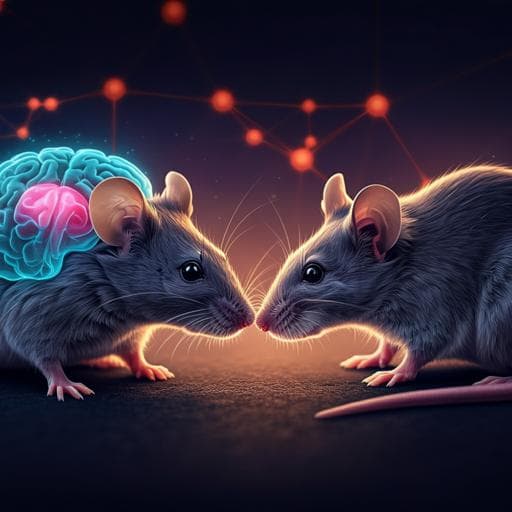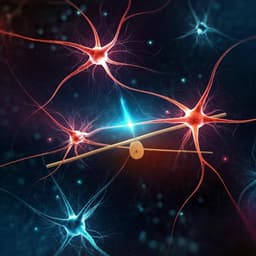
Psychology
Dynamic and stable hippocampal representations of social identity and reward expectation support associative social memory in male mice
E. Kong, K. Lee, et al.
This study by Eunji Kong, Kyu-Hee Lee, Jongrok Do, Pilhan Kim, and Doyun Lee explores the fascinating neural mechanisms tying social identity to reward value in male mice. Their findings reveal how dorsal CA1 hippocampal neurons play a critical role in associative social memory, highlighting the sophisticated social capabilities of these animals.
~3 min • Beginner • English
Introduction
Animals in social groups must recognize individual conspecifics and retrieve/update values associated with them to guide adaptive social behavior. The hippocampus, long implicated in episodic memory (what-where-when), also processes social information. Given extensive evidence that dorsal CA1 encodes reward-related signals and receives social information from dorsal CA2, the authors asked whether dorsal CA1 supports associating social identities with reward value. They developed social Go–NoGo paradigms requiring male mice to discriminate equally familiar littermates by idiosyncratic features and link identities to reward availability, aiming to reveal CA1 activity related to individual identity and reward expectation and to assess its stability across days.
Literature Review
Prior work shows dorsal CA1 encodes reward-related information: over-representation of reward locations, remapping with reward relocation, and neurons encoding reward expectation independent of location/context, including quantitative expected value and abstract value spaces. CA1 appears critical for updating reward value. Although most reward findings are in spatial contexts, hippocampus is also implicated in associating reward with social cues (e.g., social transmission of food preference) and in discriminating conspecifics tied to aversive outcomes, with dorsal CA1 inactivation impairing such associations. Human hippocampus represents social constructs like affiliation and power. Dorsal CA1, heavily innervated by social-processing CA2, is thus a candidate site for linking social identity and value. Previous studies also show CA2/ventral CA1 roles in social memory and identity decoding in other regions, providing a framework for examining CA1's contribution to associative social memory.
Methodology
- Subjects and stimuli: Male C57BL/6J mice as subjects; male littermate stimulus mice matched for sex, age, genetics, and familiarity. Subjects singly housed and water-restricted during training. Stimulus presentations confined to task sessions to equalize familiarity.
- Behavioral setup: Head-fixed subject and head-fixed stimulus mice on a rotating platform behind an interaction window. Nose-to-nose investigation enabled during a 4 s window per trial. Trials repeated every ~12 s. Lighting tests included light vs dark conditions.
- Two-mouse Go–NoGo social discrimination: After rule learning (mouse vs empty device), subjects learned to discriminate two familiar littermates: one associated with reward (Go) and the other with no reward (NoGo). After window opening, a 0.8–1.3 s grace period discouraged premature licks; a subsequent response window allowed licking to yield ~4 µl water on Go trials, not on NoGo trials. Mice performed ~300 trials/session to criterion (>80% correct) and experienced reversal learning (swapping reward contingency).
- Long-term memory tests: Compared performance before vs after 72 h (two-mouse task) or 6-day (four-mouse task) breaks; in separate cohorts, reward contingency was reversed after breaks to test for memory-driven below-chance performance initially.
- Controls and necessity: Bilateral dorsal hippocampal (centered on CA1) muscimol inactivation vs saline vs no-injection controls in well-trained mice. A matched non-social odor Go–NoGo task (citral vs 1-butanol; and a four-odor version with additional odors) was used to assess specificity.
- Four-mouse social discrimination: Modified task with four littermates—two reward-associated (A,B) and two no-reward-associated (C,D)—presented pseudo-randomly. Behavior identical within a category; neuronal differences between A vs B or C vs D attributable to identity, not value or action.
- Passive social exposure: In trained mice, a novel set of four stimulus mice (E–H) not associated with reward were passively presented to test identity encoding without task engagement.
- Imaging: Two-photon calcium imaging of dorsal CA1 pyramidal neurons in Thy1-GCaMP6f mice during tasks. Fields of view 800×800 µm at 30 Hz. Motion artifacts removed; ΔF/F0 computed; calcium event thresholding applied. Neurons tracked across days using probabilistic cell registration with <5% estimated error.
- Analyses:
- Neuronal responsiveness: Compare pre-stimulus vs stimulus periods; classify activated/inhibited/non-responsive.
- Discriminability index (d′): Computed per neuron for Go vs NoGo within O–R period; for identity (A vs B; C vs D) within O–C period; significance via trial label shuffling (top/bottom 2.5%). Multiple-comparison correction in passive condition.
- Reward- vs stimulus-selective classification in reversal: Neurons maintaining Go/NoGo preference across reversal deemed reward/no-reward selective; those reversing deemed stimulus-selective. Contingency table and chi-square with post-hoc adjusted residuals.
- SVM decoding: Linear SVMs (leave-one-trial-out) at each time point to decode Go/NoGo or identity (binary within category; multiclass in passive viewing). Across-day decoders trained on day 1 and tested on day n to assess stability; significance by cluster-based permutation tests.
- Statistics: Wilcoxon signed-rank, Kruskal–Wallis with Dunn’s post-hoc, chi-square, Pearson correlation, with p<0.05 threshold. Data reported as mean ± SEM.
Key Findings
- Behavior and sensory basis:
- Mice learned the individual discrimination (two-mouse) to >80% in 3.4 ± 1.9 days (n=20) after rule learning (3.0 ± 0.9 days). Performance did not differ between light and dark (Wilcoxon p=0.383, n=8), indicating discrimination did not require vision.
- Long-term memory: After 72 h break, performance remained high from session start (Wilcoxon p=0.688, n=7). With reversal after the 72 h break, initial performance dropped below chance (Wilcoxon p=0.008, n=8), indicating retained pre-break identity–value associations. In the four-mouse task, performance was maintained after a 6-day break (Wilcoxon p=0.54, n=7).
- Necessity of dorsal hippocampus (CA1-centered):
- Muscimol injection impaired social discrimination performance to near chance and increased first-lick latency dispersion; saline had no effect (Kruskal–Wallis with Dunn’s post-hoc: Ctrl vs Mus p=0.003; Mus vs Sal p=0.014; n≈7). Muscimol did not impair non-social odor discrimination or response time.
- Neural coding of reward expectation in social tasks:
- Population decoding of Go/NoGo rose after window opening and correlated with behavioral performance (example mouse Pearson r=0.82, p=7.87×10⁻10; significant correlations in 8/11 mice; pooled significant).
- In reversal analyses (1-day-apart pairs; 1617 neurons from 5 mice), 21.3% (Go-preferring) and 12.3% (NoGo-preferring) on day 1; similar on day 2. Critically, 42.3% of Go-preferring and 32.2% of NoGo-preferring neurons maintained preference across reversal (above chance), identifying reward- and no-reward-selective neurons independent of stimulus identity. Pointwise d′ increased after window opening and before reward delivery, consistent with expectation coding.
- Stability: Reward- and no-reward-selective neurons remained preferential across four consecutive daily reversals (e.g., from days 2–3: 63 reward-specific, 37 no-reward-specific; day 1 Go pref 64.5% of reward neurons; day 4 Go pref 61.3%; day 1 NoGo pref 59.0% of no-reward neurons; day 4 NoGo pref 53.8%; highly significant chi-square tests). Reward-preferring stability persisted up to ~10 days in many session pairs, though declining with interval.
- Absence of reward-selective coding in non-social odor Go–NoGo:
- Fewer responsive neurons overall vs social task; proportions of neurons maintaining Go/NoGo preference across reversal were not above chance. Instead, many neurons reversed preference, maintaining odor selectivity.
- Across-day SVM decoding in non-social tasks favored odor stimulus prediction rather than Go/NoGo, contrasting with social tasks where decoding favored reward expectation (Supplementary analyses).
- Neural coding of social identity (four-mouse task):
- Behavior: Mice reached criterion in 2.2 ± 1.7 days (n=14). Licking to the two reward-associated mice did not differ (Wilcoxon p=0.76).
- Go/NoGo coding: 26.9% ± 0.01% of neurons had significant d′; SVM population decoding of Go/NoGo was above chance and robust.
- Identity coding: During O–C, 21.4% ± 0.8% of CA1 neurons discriminated between individual mice; 12.3% ± 0.6% for reward-associated pair (A vs B), 9.3% ± 0.6% for no-reward pair (C vs D), and 2.1% ± 0.3% for both. Proportion of identity-selective neurons was higher in reward than no-reward category (Wilcoxon p=0.0018, n=13). Among neurons with positive response scores, ~30% were identity-selective, indicating amplitude modulation supports identity discrimination.
- Population identity decoding: SVM decoding accuracy rose rapidly after stimulus encounter; peak decoding higher for reward vs no-reward pairs (85.4% ± 1.2% vs 81.6% ± 1.7%; Wilcoxon p=0.046, n=13).
- Passive viewing (no reward association): 8.8% ± 0.8% of neurons discriminated identities (above chance), and multiclass SVM decoded 4 identities above chance.
- Stability and representational drift:
- Across consecutive days (54 pairs, 12 mice), a subset maintained identity preference: stable fractions 16.9% ± 2.8% (reward) and 18.2% ± 3.7% (no-reward), both above chance; reversed selectivity not above chance. Across-day population decoders predicted identity up to 4 days apart but with reduced peak accuracy vs within-day; across-day Go/NoGo decoding similarly declined with interval.
- Non-social four-odor task:
- 31.4% ± 0.8% of neurons discriminated odors (10.7% ± 0.7% reward-pair; 17.6% ± 0.4% no-reward-pair; higher in no-reward; Wilcoxon p=5.8×10⁻7, n=7). Population decoding was robust, with higher peaks in no-reward category. Stable identity fractions across days were 19.1% ± 3.2% (reward) and 31.1% ± 3.7% (no-reward). Across-day vs within-day decoding drop was larger for social than non-social tasks, indicating faster drift for social representations.
Discussion
The study shows that male mice can rapidly and reliably recognize individual familiar conspecifics via brief nose-to-nose olfactory investigation, independent of visual cues. Dorsal CA1 activity is necessary for this individual discrimination but not for comparable non-social odor discrimination, indicating a specific role in social identity processing rather than general odor or task structure processing. Two-photon imaging reveals that dorsal CA1 neurons encode the expectation of reward presence or absence during social tasks, with selectivity that persists across reversal learning and days, highlighting a stable value-related code independent of the associated social stimulus identity. In contrast, neuronal representations of individual mouse identity are accurate within sessions yet dynamic across days, with only a subset of neurons maintaining identity preferences; nevertheless, identity information at the population level can be decoded across days, suggesting a dynamic but overlapping coding scheme that supports stable behavioral performance.
These findings address the core question by dissociating value and identity representations within CA1: reward expectation signals are stable and generalize across stimulus identities, while social identity codes are dynamic yet reliable enough for accurate decoding within a session. The absence of reward-selective coding during non-social odor tasks underscores a context dependence: dorsal CA1 acquires reward-predictive coding specifically when rewards are associated with social stimuli, pointing to a hippocampal role in binding social identity to value. The relatively rapid drift of social identity coding compared to non-social odor identity, alongside the necessity of dorsal CA1 for social discrimination, suggests that CA1 operates within a broader circuit (including CA2, ventral CA1, and medial prefrontal cortex) that supplies identity information while CA1 provides associative and expectation coding necessary for decision-making in social contexts.
Conclusion
This work establishes that dorsal hippocampal CA1 in male mice supports associative social memory by concurrently encoding stable reward expectation signals and dynamically representing individual social identities. Behaviorally, mice discriminate familiar individuals via brief olfactory contact and retain these memories for days even when singly housed. Functionally, CA1 is required for social but not non-social odor discrimination. Reward expectation neurons in CA1 remain selective across reversals and days, whereas identity-selective neurons reliably discriminate individuals within sessions but drift across days while supporting above-chance across-day decoding at the population level. The specificity of reward-predictive coding to social tasks implies a hippocampal role in linking social identity with value.
Future directions include: expanding cohorts to characterize the conditions under which no-reward-selective neurons emerge; testing whether CA1 reward-expectation signals reflect motor anticipation (e.g., licking) versus reward prediction; mapping upstream/downstream circuits (CA2, ventral CA1, mPFC) that contribute identity information and read out CA1 codes; and probing causal roles of identified neuronal subpopulations in flexible updating of social identity–value associations.
Limitations
- Reward-selective neurons might reflect anticipation of licking rather than reward expectation; although analyses focused pre-reward, motor anticipation cannot be fully excluded.
- No-reward-selective neurons were prominent in only a subset of mice that underwent extensive reversal learning; larger cohorts are needed to generalize this finding.
- Stable identity coding across reversals was not found, suggesting reorganization with learning; the study cannot determine where stable identity engrams are stored (e.g., ventral CA1, CA2, mPFC are candidates).
- The study did not directly test dorsal CA1 involvement in novel vs familiar discrimination paradigms; task differences limit direct comparison with social novelty preference results.
- Head-fixation and constrained interactions may limit generalization to freely moving social contexts.
- All subjects were male; sex differences were not assessed.
Related Publications
Explore these studies to deepen your understanding of the subject.







